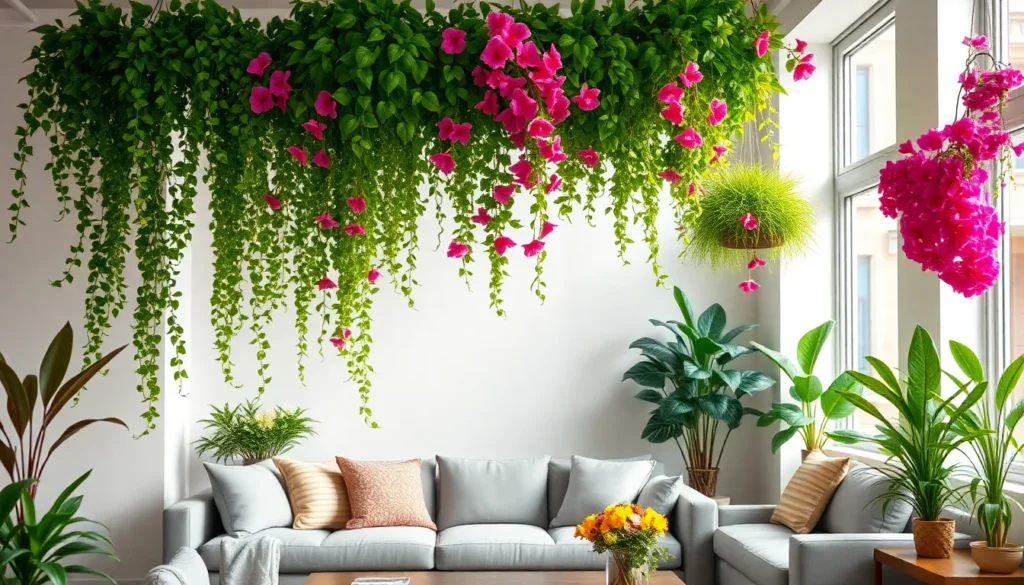We’ve all been there – staring at bare walls and empty corners wondering how to breathe life into our spaces without the constant worry of watering schedules and plant care. Hanging artificial plants offer the perfect solution for busy homeowners who crave that fresh botanical aesthetic without the maintenance headaches.
Today’s artificial plants have come a long way from their plastic predecessors. Modern faux greenery looks incredibly realistic and can transform any room into a lush sanctuary. Whether you’re dealing with low-light areas where real plants struggle or you simply want foolproof décor that stays gorgeous year-round hanging artificial plants deliver instant impact.
We’ll show you how to strategically place these versatile decorative elements to create stunning visual interest throughout your home. From bohemian macramé hangers to sleek modern planters artificial hanging plants can complement any design style while giving you the green oasis you’ve always wanted.
Choose the Right Artificial Plants for Hanging Displays
Selecting the perfect artificial plants for hanging displays requires careful consideration of several key factors. We’ll guide you through the essential elements that make hanging artificial plant decor both beautiful and believable.
Consider Size and Scale for Your Space
Measure your ceiling height before selecting hanging artificial plants to ensure proper proportions. Rooms with 8-foot ceilings work best with compact hanging plants like pothos or small ferns that extend 12-18 inches downward. Higher ceilings accommodate dramatic trailing varieties such as artificial ivy or Boston ferns that can cascade 2-3 feet.
Scale your hanging plant size to match your room dimensions. Large spaces benefit from multiple medium-sized hanging plants rather than one oversized specimen. Small rooms require delicate hanging varieties like artificial air plants or mini succulents to avoid overwhelming the space.
Position hanging artificial plants at eye level or slightly above for maximum visual impact. We recommend hanging plants 6-8 feet from the floor in living rooms and 7-9 feet in entryways. This placement creates natural sight lines without blocking walkways or conversation areas.
Select Realistic-Looking Foliage and Textures
Choose artificial plants with varied leaf textures that mimic natural imperfections. High-quality hanging artificial plants feature leaves with different shades of green, slight browning on edges, and natural-looking veining. Avoid uniform coloring that screams artificial.
Feel the leaves before purchasing to assess texture quality. Premium artificial hanging plants use silk or high-grade polyester materials that feel soft and flexible like real foliage. Plastic leaves appear shiny and stiff, immediately revealing their artificial nature.
Look for hanging artificial plants with realistic stem construction and natural draping. Quality specimens feature flexible wire stems covered in natural-looking bark or green coating. The stems should bend and curve naturally rather than hanging straight down in rigid lines.
Pick Plants That Match Your Interior Style
Match your hanging artificial plant selection to your existing decor style. Modern minimalist spaces benefit from clean-lined hanging plants like artificial snake plants or geometric air plant displays. Traditional interiors pair beautifully with classic hanging ferns or ivy varieties.
Consider color coordination when selecting artificial hanging plants for your space. Bohemian styles embrace varied green tones and trailing textures like artificial macramé plant hangers with mixed foliage. Contemporary spaces prefer monochromatic green schemes with structured hanging planters.
Select hanging artificial plants that complement your room’s function and mood. Kitchens benefit from herb-like hanging plants such as artificial rosemary or trailing thyme varieties. Bedrooms create tranquil atmospheres with soft hanging ferns or delicate trailing succulents.
Find the Perfect Locations for Hanging Artificial Plants Decor
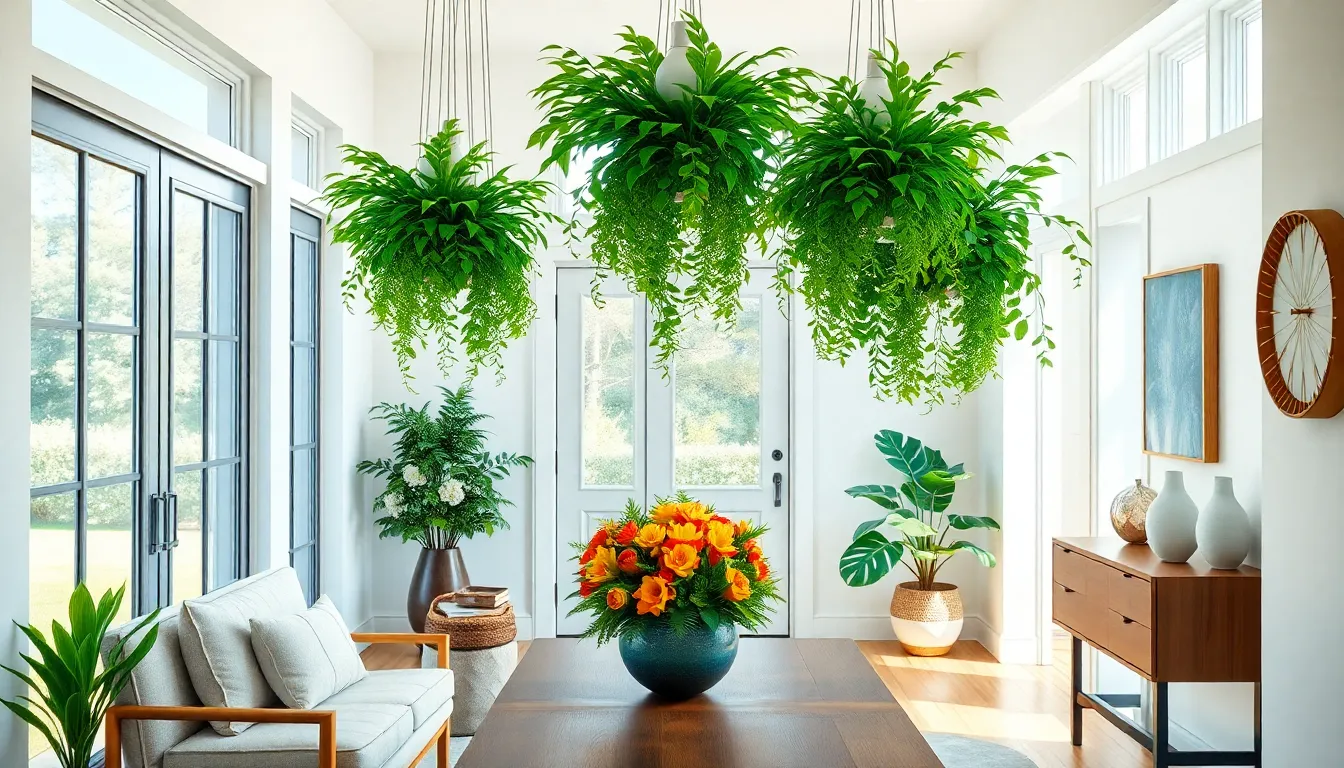
Strategic placement transforms your artificial hanging plants from simple decor into stunning focal points that enhance your home’s atmosphere.
Identify High-Traffic Areas That Need Greenery
Entryways create the perfect opportunity to welcome guests with lush hanging displays that make memorable first impressions. Living rooms benefit from artificial plants positioned above seating areas or near conversation zones where they’ll soften harsh lines and add natural warmth. Office reception areas and hallways gain instant vitality when we hang faux greenery in spaces where people frequently gather or pass through.
Kitchens work exceptionally well with herb-like artificial plants suspended above islands or breakfast nooks, creating a fresh culinary atmosphere. Bathrooms transform when we add hanging plants near vanities or above tubs, bringing spa-like tranquility to these functional spaces. Dining rooms feel more inviting with artificial greenery hung at the room’s perimeter or above buffet areas where they won’t interfere with conversations.
Consider Lighting Conditions and Visibility
Natural light enhances the vibrant appearance of artificial foliage, making plants look more realistic and eye-catching when positioned near windows. Ambient lighting from overhead fixtures or table lamps creates the ideal environment for showcasing your hanging displays without causing damage. Direct sunlight poses risks to artificial plants as prolonged exposure leads to fading and deterioration of synthetic materials over time.
Visibility becomes crucial when selecting hanging locations since plants should complement rather than compete with existing decor elements. Well-lit corners and areas with consistent illumination help artificial plants maintain their fresh appearance throughout the day. Strategic positioning near light sources ensures your hanging displays remain prominent features that draw positive attention from visitors.
Measure Ceiling Height and Available Space
Ceiling measurements determine the maximum drop length for your hanging artificial plants, preventing awkward placement that disrupts room flow. Standard 8-foot ceilings accommodate plants with 2-3 foot hanging lengths, while higher ceilings allow for more dramatic cascading displays. Available space around furniture and walkways requires careful consideration to avoid creating obstacles or visual clutter.
Marking potential hanging spots helps visualize how artificial plants will interact with existing room elements before installation. Measuring distances between hanging points ensures balanced spacing that creates harmonious visual rhythm throughout the space. Proper measurements prevent common mistakes like hanging plants too low over dining tables or too high to appreciate their decorative impact.
Select Appropriate Hanging Hardware and Containers
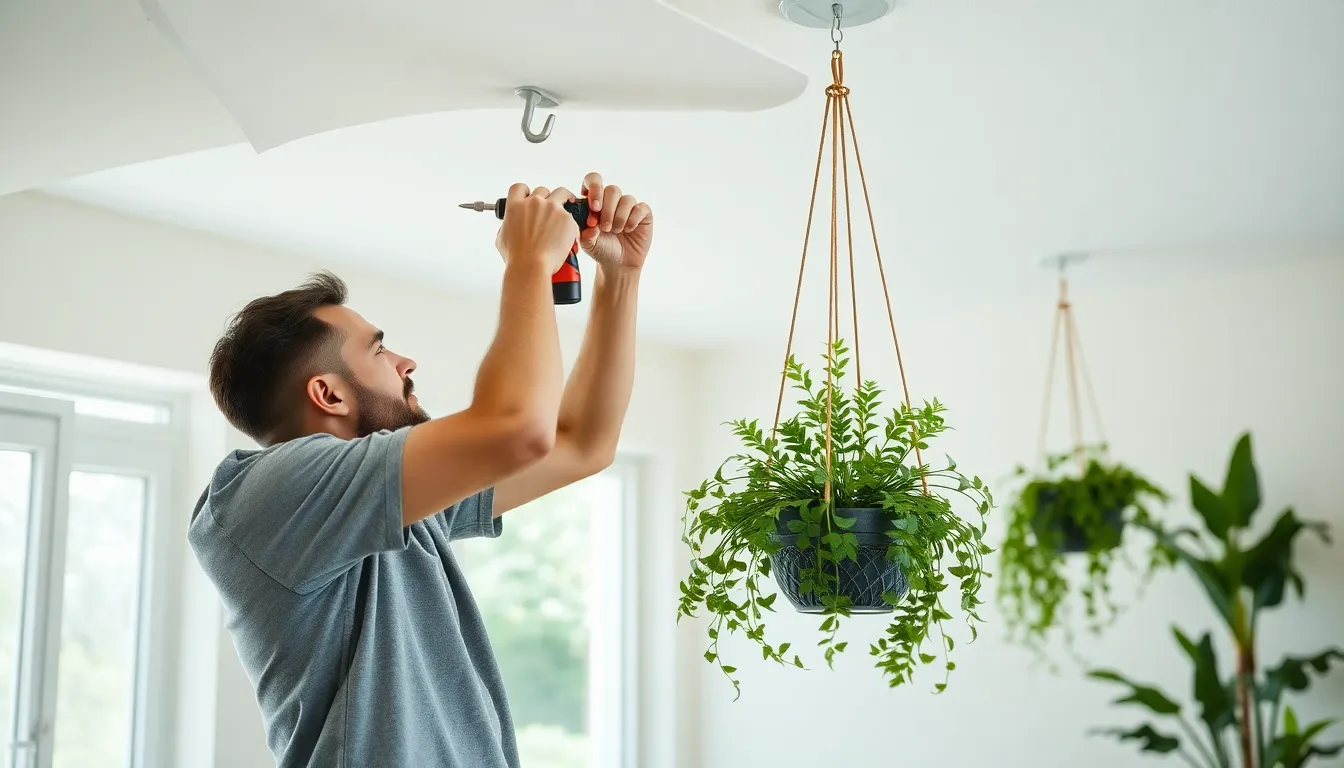
Once you’ve chosen the perfect artificial plants and identified optimal locations, we need to focus on the essential foundation: proper hardware and containers that’ll keep your greenery safely suspended and beautifully displayed.
Choose Sturdy Ceiling Hooks and Mounting Systems
Heavy-duty ceiling hooks rated for your plant’s combined weight should be your first consideration when planning installations. We recommend using screw-in anchors specifically designed for your ceiling type, whether it’s drywall, plaster, or concrete construction.
Drilling pilot holes and inserting appropriate wall anchors prevents damage while ensuring secure attachment points that won’t fail over time. S-hooks and mounting brackets provide versatile connection options between your ceiling hardware and hanging containers.
Position these mounting points strategically to avoid ceiling fans, light fixtures, and high-traffic walkways where people might bump into suspended plants. We suggest measuring twice and marking hook locations with a pencil before drilling to ensure perfect spacing and alignment.
Pick Decorative Planters and Hanging Baskets
Match your container style with your room’s existing aesthetic to create a cohesive look that enhances rather than clashes with your decor. Woven baskets work beautifully in bohemian and farmhouse settings, while sleek metal planters complement modern and industrial design schemes.
Varying container sizes and materials creates visual depth when you’re displaying multiple hanging plants in the same space. Ceramic pots offer classic elegance, while lightweight plastic options reduce stress on ceiling mounting points without sacrificing style.
Consider containers with integrated hanging chains or hooks that simplify installation and allow easy repositioning when you want to refresh your arrangement. We find that planters with drainage-style holes (though unnecessary for artificial plants) add authentic detail that makes faux greenery more convincing.
Ensure Weight Distribution and Safety
Confirm your ceiling structure can support the total weight before installing multiple hanging plants or heavy decorative containers. We always test ceiling strength by gently pulling on installed hooks before adding plants to identify any weak mounting points.
Distribute weight evenly across multiple ceiling hooks when creating grouped displays or tiered arrangements that could stress individual attachment points. Space heavy planters at least 24 inches apart to prevent concentrated load bearing on small ceiling areas.
Keep hanging artificial plants positioned well above head height and away from children’s reach to maintain both decorative integrity and household safety. We recommend hanging plants at least 8 feet from the floor in areas where kids play frequently.
Create Stunning Visual Arrangements with Multiple Plants
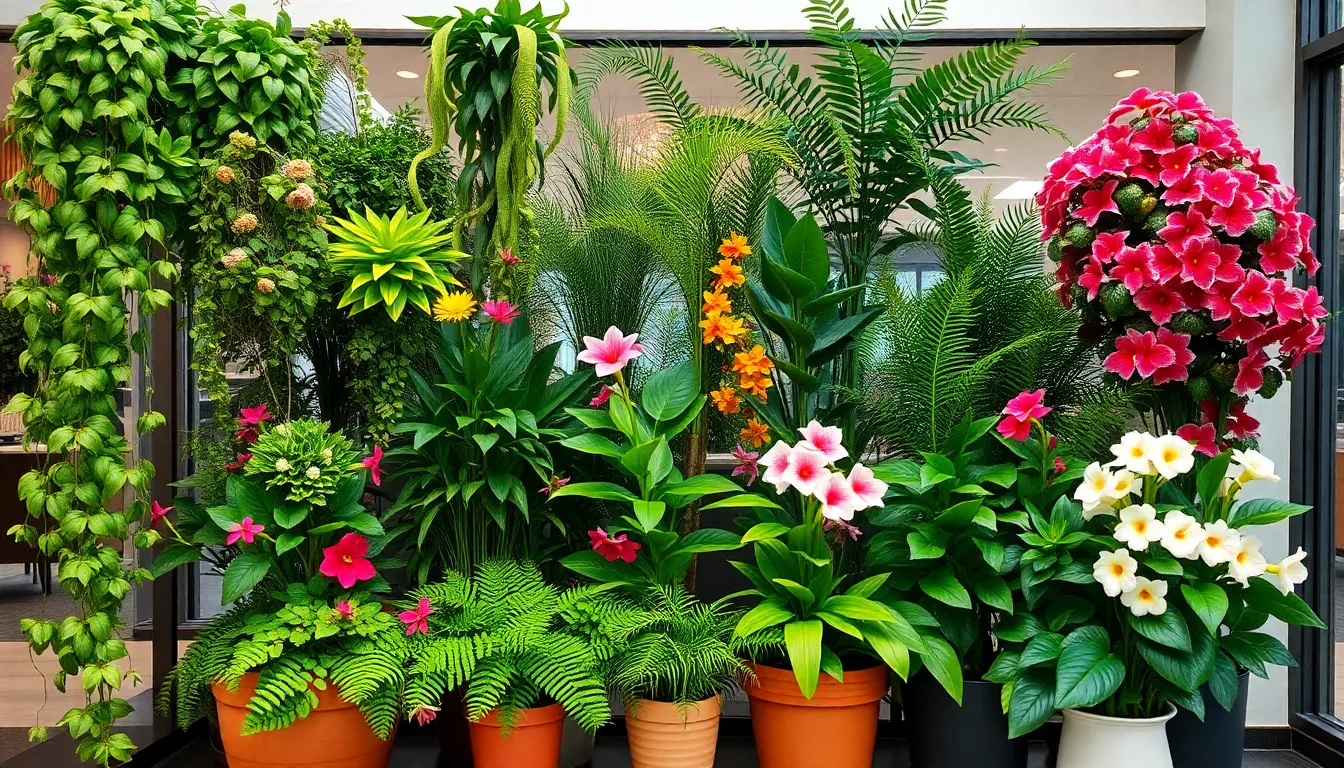
We’ve covered the basics of hardware and placement, but now let’s focus on creating arrangements that truly capture attention. Multiple artificial plants working together produce a lush, full appearance that single specimens simply can’t achieve.
Vary Heights and Lengths for Ever-changing Displays
Heights and lengths create the visual depth that transforms flat displays into captivating scenes. Professional designers layer plants at various heights and pot levels to establish a natural, flowing visual effect that draws the eye throughout the space.
Longer trailing vines serve as focal points while adding movement to your arrangement. We recommend positioning these cascading elements at different lengths to avoid monotonous symmetry. Shorter plants fill in the base and middle layers, providing fullness that mimics how vegetation naturally grows in clusters.
Consider hanging your tallest artificial plants from the highest points, then gradually decrease heights as you move outward. This technique creates a waterfall effect that guides visitors’ eyes naturally through your space while maintaining visual balance.
Mix Different Plant Types and Textures
Different plant types and textures enhance realism while creating visual interest that keeps arrangements from appearing monotonous. Combining artificial ferns, pothos, philodendrons, and flowering plants like bougainvillea or hibiscus delivers year-round color and texture without any maintenance requirements.
Leafy vines such as English ivy or pothos pair beautifully with more textured specimens like birds nest fern or flowering artificial plants. This variety offers the natural look that makes artificial arrangements convincing and vibrant.
We suggest incorporating at least three different leaf shapes within each grouping. Broad leaves contrast nicely with narrow, pointed foliage, while flowering elements add pops of color that break up green monotony. Mixing smooth and textured surfaces creates additional visual complexity that mirrors nature’s diversity.
Group Plants in Odd Numbers for Natural Appeal
Odd numbers create visually appealing, natural looking clusters that avoid the artificial symmetry of even groupings. We recommend arranging plants in groups of 3, 5, or 7 to achieve balanced asymmetry that’s typical in nature.
Three plant groupings work perfectly for smaller spaces like bathrooms or entryways, while larger areas can accommodate five or seven plant clusters. Each grouping should include plants of varying heights and textures to maximize the natural effect.
Asymmetrical arrangements enhance the decorative impact by creating visual tension that keeps viewers engaged. Even numbered groupings often appear too formal and structured, while odd numbers produce the organic randomness that makes artificial plants look authentically placed rather than obviously arranged.
Style Different Rooms with Hanging Artificial Plants Decor
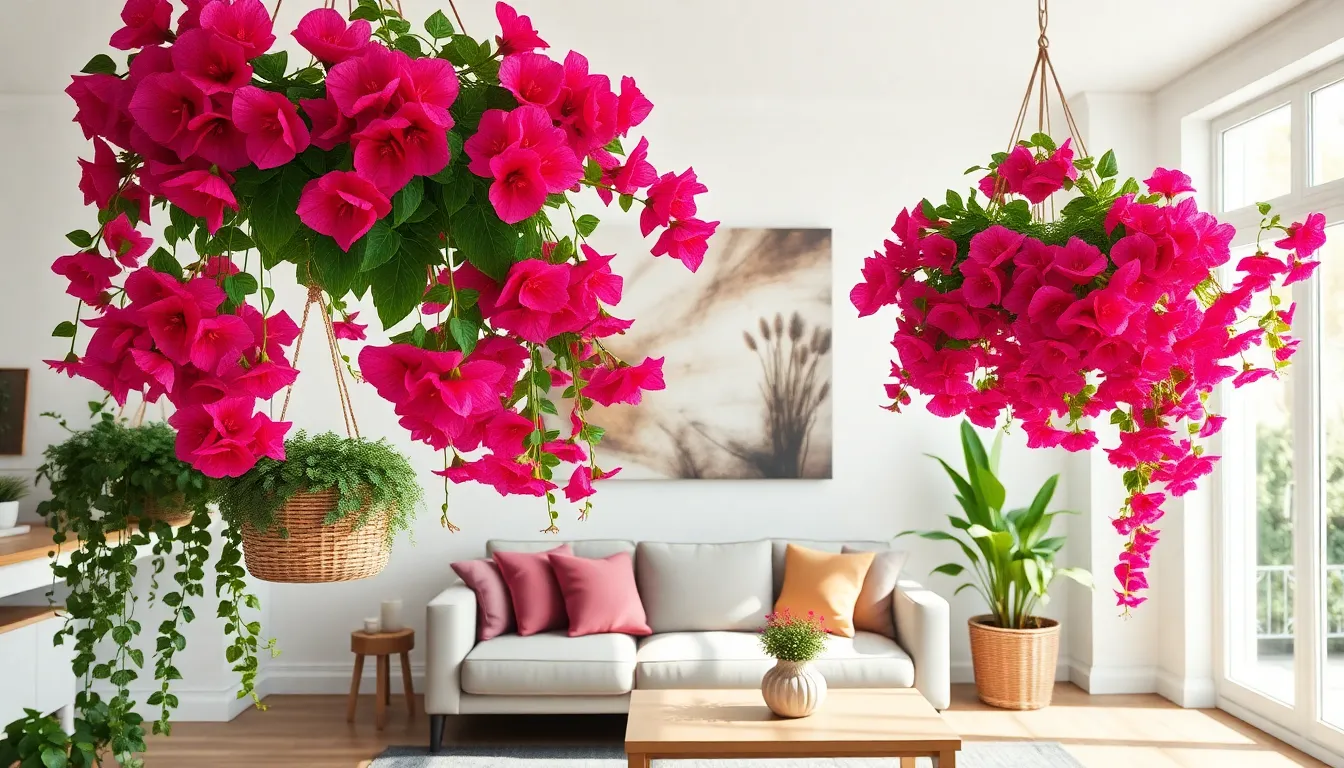
We can transform every room in our home by tailoring artificial hanging plants to match each space’s unique style and function. Different rooms benefit from exact plant varieties that complement their purpose and aesthetic.
Transform Living Rooms with Statement Pieces
Living rooms become instantly more vibrant when we incorporate large, eye-catching hanging artificial plants as statement pieces. Bougainvillea blooms create dramatic tropical flair that draws attention and sparks conversation. Cascading ivy varieties soften harsh corners while adding vertical interest that makes ceilings appear higher.
We recommend positioning these statement pieces in high-traffic areas where they’ll make the strongest visual impact. Hanging baskets work exceptionally well for creating natural room divisions without blocking light or views. Trailing vines like artificial pothos or philodendron add movement and texture that makes living spaces feel more welcoming and ever-changing.
Add Greenery to Kitchens and Dining Areas
Kitchens and dining spaces thrive with hanging artificial plants that bring life and color without creating maintenance headaches. Faux geraniums add bright pops of color above kitchen islands or breakfast nooks. Trailing vine varieties work perfectly above counters and cabinets where real plants would struggle with heat and limited light conditions.
We suggest placing hanging plants beside windows or above dining tables to create focal points that enhance mealtime experiences. Kitchen spaces benefit from plants that can handle steam and temperature fluctuations without wilting. Artificial herbs like basil or rosemary hanging in small pots provide both visual appeal and thematic relevance for cooking areas.
Create Spa-Like Atmospheres in Bathrooms
Bathrooms transform into relaxing spa-like retreats when we add hanging artificial plants that thrive in humid environments. English ivy and pothos varieties work exceptionally well in these spaces because they resist mold and mildew while softening harsh bathroom lines. High bathroom windows become perfect showcases for cascading greenery that creates privacy without blocking natural light.
We recommend choosing plants with lush, tropical foliage that complements the soothing atmosphere we want in bathrooms. Fern varieties add natural texture that pairs beautifully with spa-inspired color schemes. These moisture-resistant options maintain their appearance in steamy conditions where live plants would quickly deteriorate.
Maintain Your Hanging Artificial Plants for Longevity
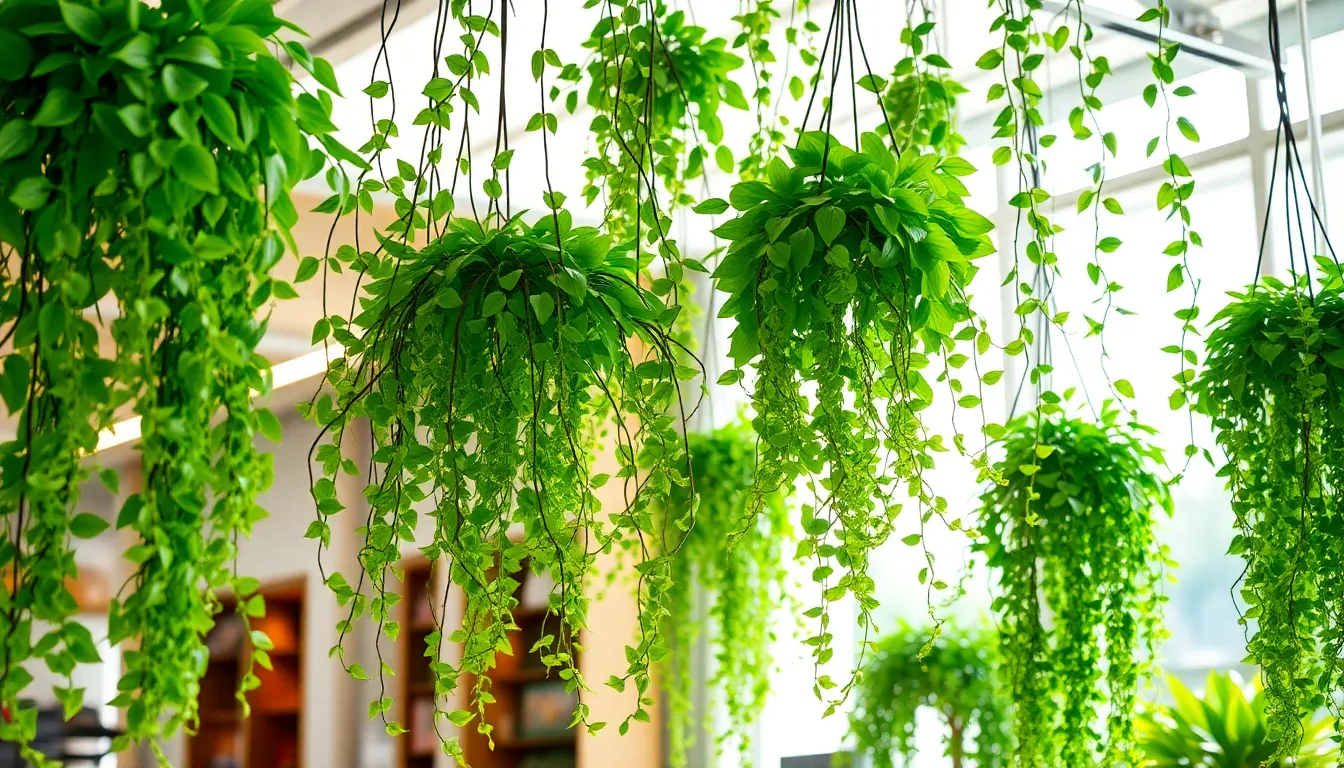
Once you’ve created your perfect hanging display, proper maintenance ensures your artificial plants continue looking vibrant and realistic for years to come. Regular care prevents dust buildup and keeps your faux greenery as stunning as the day you installed it.
Clean and Dust Regularly for Fresh Appearance
Dust accumulation on artificial hanging plants reveals their synthetic nature and dulls their vibrant colors. We recommend dusting your plants monthly using a feather duster or soft, dry cloth, wiping gently from top to bottom of each leaf to maintain their fresh appearance.
Heavy dust buildup requires a more thorough approach. Use a blow dryer on a cool, low setting before dusting to loosen stubborn particles, or wipe occasionally with a damp cloth to remove grime without damaging the material. For outdoor artificial plants, a gentle spray with water on a low hose setting effectively cleans the foliage.
Cleaning frequency depends on your home’s dust levels and air quality. High traffic areas and homes with pets may require more frequent attention to keep your hanging plants looking their best.
Check Hardware and Adjust Positioning
Hardware inspection prevents dangerous falls and maintains the safety of your hanging plant display. We suggest checking hooks, screws, and mounting systems regularly to ensure they remain securely anchored and can support the combined weight of your plants.
Installation safety requires careful planning and proper technique. Mark ceiling spots precisely and drill pilot holes when needed, ensuring support anchors connect to ceiling studs whenever possible for maximum stability. Avoid electrical wires and plumbing during installation to prevent costly damage.
Weight distribution becomes crucial as artificial plants can be heavier than expected, especially larger specimens with multiple trailing vines. Monitor your hardware for signs of strain or loosening that could compromise the display’s integrity.
Rotate Plants to Prevent Fading
UV exposure causes artificial plants to fade or discolor unevenly over time, particularly those near windows or in bright rooms. We recommend rotating your plants monthly to ensure sunlight exposure distributes evenly across all surfaces, reducing noticeable color variations.
Direct, prolonged sunlight accelerates fading and can make your artificial foliage look washed out or unrealistic. Position plants away from intense afternoon sun or use window treatments to filter harsh light while maintaining the bright, airy feel you want.
Rotation also allows you to fluff leaves and arrange vines for optimal fullness and natural appearance. Adjust cascading elements and spread foliage evenly to prevent flat or tangled looks that diminish the realistic effect you’ve worked to achieve.
Avoid Common Mistakes with Hanging Plant Displays
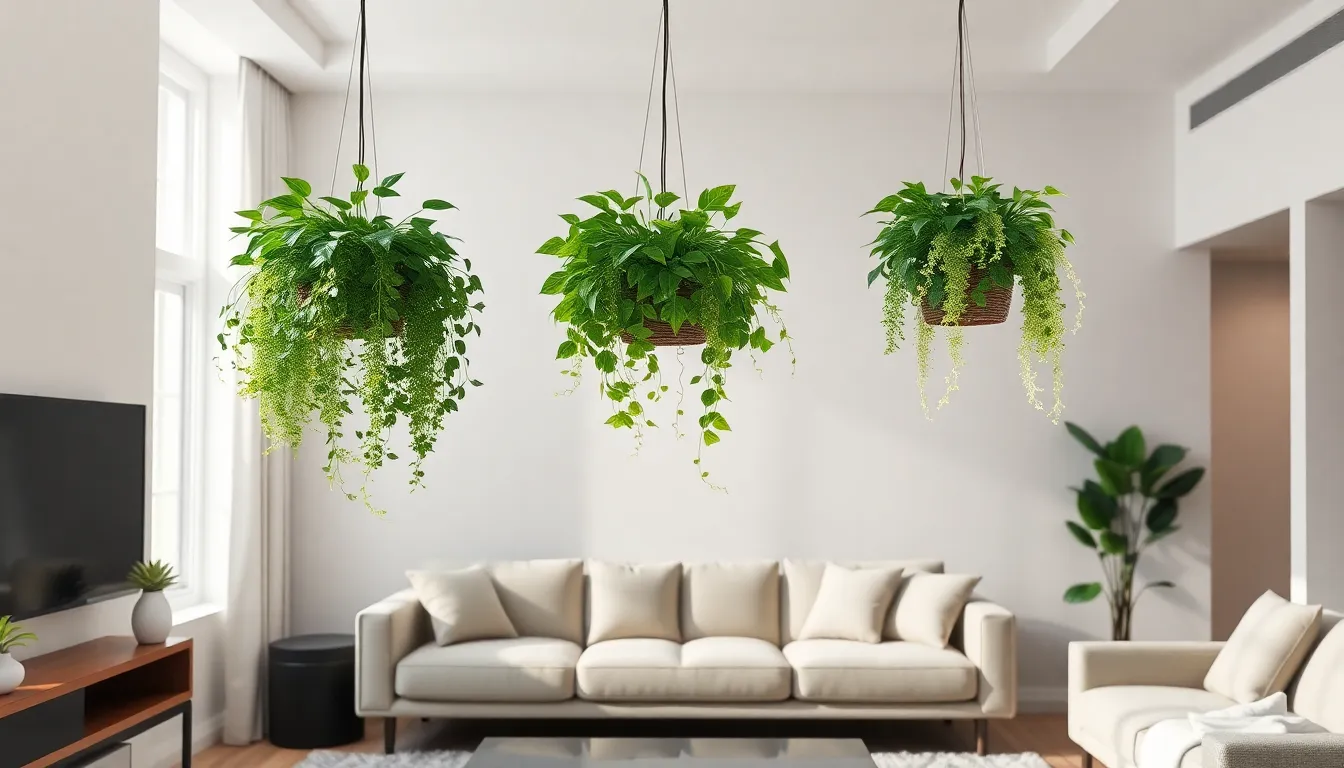
Even with careful planning, we can easily fall into common traps that diminish the beauty of our hanging artificial plant displays. Learning from these mistakes helps us create more sophisticated and visually appealing arrangements.
Don’t Overcrowd Your Space with Too Many Plants
Overcrowding creates a cluttered appearance that makes our rooms feel chaotic rather than stylish. We should limit the number of hanging plants per room to maintain visual balance and allow each piece to shine as a decorative element.
Spacing becomes crucial when we’re working with multiple hanging displays. We need to leave adequate room between plants so they don’t compete for attention or create a jungle-like atmosphere that overwhelms the space.
Consider the room’s primary function before adding multiple hanging elements. We can use the rule of thirds: no more than three hanging plants in smaller rooms, with larger spaces accommodating additional pieces only if they’re strategically placed.
Visual breathing room enhances the impact of each artificial plant display. We should step back and evaluate whether our arrangements feel intentional and curated rather than randomly placed throughout the ceiling space.
Avoid Placing Plants in Awkward or Unsafe Locations
Safety concerns take priority when we’re selecting locations for our hanging displays. We must avoid areas where people might bump into plants or where they could fall and cause accidents.
High traffic pathways require careful consideration to prevent our beautiful arrangements from becoming obstacles. We should keep hanging plants away from doorways, narrow hallways, and spaces where people frequently walk with their hands raised.
Children and pets need protection from hanging displays that could pose risks. We recommend installing plants at least 8 feet from the floor in areas where little ones play or where curious pets might try to reach them.
Furniture placement affects accessibility and safety around our hanging arrangements. We should ensure that plants don’t hang over seating areas where they might drip or interfere with people standing up from chairs and sofas.
Skip Low-Quality Artificial Plants That Look Fake
Quality materials make the difference between convincing artificial foliage and obviously fake plants that cheapen our decor. We should invest in plants with realistic textures, natural color variations, and high-quality construction that mimics real plant characteristics.
Unnatural colors immediately reveal low-quality artificial plants that can make our entire room look less sophisticated. We need to choose plants with subtle color gradations and realistic fading patterns that real plants naturally display.
Texture examination helps us identify superior artificial plants before we purchase them. We should look for varied leaf surfaces, natural-looking stems, and realistic weight distribution that matches what we’d expect from living plants.
Craftsmanship details separate premium artificial plants from cheaper alternatives that look obviously manufactured. We should seek plants with hand-finished touches, varied leaf positioning, and authentic-looking imperfections that give them character and realism.
Conclusion
We’ve shown you how hanging artificial plants can transform your home into a vibrant green sanctuary without the hassle of constant care. By choosing quality pieces and positioning them strategically you’ll create stunning focal points that enhance every room’s aesthetic.
Remember that success lies in the details – from selecting the right hardware to maintaining proper spacing and cleaning regularly. These simple steps ensure your faux greenery remains beautiful and realistic for years to come.
Now it’s time to put these ideas into action. Start with one room and gradually expand your hanging plant collection to create the lush indoor oasis you’ve always wanted. Your low-maintenance green paradise awaits!
Frequently Asked Questions
What are the main benefits of using hanging artificial plants for home décor?
Hanging artificial plants offer a low-maintenance alternative to real plants while providing the same aesthetic benefits. They require no watering, pruning, or special lighting conditions, making them perfect for busy homeowners. Modern faux plants are incredibly realistic and can enhance any room’s atmosphere without the constant care real plants demand.
How do I choose the right size artificial plants for my space?
Consider your ceiling height and room dimensions when selecting hanging plants. For standard 8-10 foot ceilings, choose medium-sized plants that hang 2-3 feet down. In larger spaces with high ceilings, opt for longer trailing varieties. Always ensure plants are positioned at eye level for maximum visual impact.
Where should I place hanging artificial plants for the best effect?
Focus on high-traffic areas like entryways, living rooms, and dining spaces where they can create memorable impressions. Consider natural light sources, as they enhance the appearance of artificial foliage. Avoid placing plants in awkward locations or where they might obstruct movement or create safety hazards.
What type of hardware do I need for hanging artificial plants?
Choose sturdy ceiling hooks and mounting systems rated for the combined weight of your plants and containers. Ensure proper installation into ceiling joists or use appropriate anchors for drywall. Safety is paramount – always follow manufacturer guidelines and consider professional installation for heavier arrangements.
How do I create visual interest with multiple hanging plants?
Vary heights and lengths to achieve a natural, flowing effect. Use odd numbers of plants for balanced groupings and mix different textures and plant types for enhanced realism. Layer plants at different heights and use longer trailing varieties as focal points to create depth and visual interest.
Which rooms work best for hanging artificial plants?
Living rooms benefit from large statement pieces like cascading ivy, while kitchens can feature colorful faux geraniums. Bathrooms work well with moisture-resistant varieties like English ivy and pothos. Choose plants that complement each room’s function, lighting conditions, and existing décor style.
How do I maintain hanging artificial plants?
Dust plants monthly using a soft cloth or gentle brush to prevent buildup. For heavily soiled plants, use mild soap and water, then air dry completely. Regularly check mounting hardware for stability and rotate plants occasionally to prevent UV fading from direct sunlight exposure.
What mistakes should I avoid when displaying hanging plants?
Don’t overcrowd spaces – maintain adequate spacing between plants for visual balance. Avoid placing plants in high-traffic areas where they could pose safety risks. Never compromise on quality; invest in realistic-looking artificial plants with natural textures and colors to maintain sophisticated home décor.
How high should I hang artificial plants from the floor?
Hang plants at least 8 feet from the floor in areas frequented by children for safety. In general living spaces, position plants so the lowest point is around 6-7 feet high to avoid head bumps while maintaining visual appeal and accessibility for maintenance.
Can I mix different types of artificial plants together?
Yes, mixing different plant varieties creates more realistic and visually interesting displays. Combine various textures, leaf shapes, and trailing lengths to mimic natural growth patterns. Use a cohesive color palette that complements your existing décor while incorporating different plant types for enhanced authenticity.

